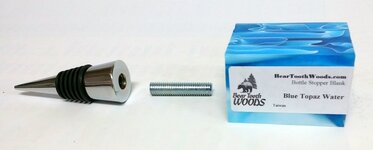There is enough "slop" in the threads to take care of having to face the end of the blank. If the end of the blank is flat, it will seat flat to the top of bottle stopper.
I am SO not a fan of that design or philosophy. If the threads are that sloppy, there's a danger of it coming loose on you! Of course, you can turn most of the stopper by bringing up the tailstock and applying pressure, which will keep the blank on the mandrel, but you have to pull it away sometime to finish it up.
I use a different bit than what is called for in the bottle stopper plans and I cut a neat and slightly undersized hole than what you would make for metal. I then run the tap and bottom it in the hole.
Without a drill press, it's a little trickier ... you need a faceplate with a glue block. First, mark your center, and bring the tailstock up close with a 60 degree live center or similar. With a piece of newspaper in between the block and the faceplate glue block (to facilitate easy removal), take a dab of heavy superglue and glue your block to the faceplate's glue block, and center your tailstock on your center mark ... use the tailstock to press the blank to the faceplate and achieve a squared surface to work with.
With tailstock still in position, face the blank close to the center point with a parting tool or cutoff tool. You can pull the tailstock away to finish the very center. Then, drill the hole on the lathe ... You can also chuck your TAP in the tailstock drill chuck and FEED THE TAP BY HAND INTO YOUR WORK.
DO NOT TURN THE LATHE ON TO TAP THE WOOD. This ensures that your tapped hole and threads are perfectly aligned and straight.
Once this is done, you can reinforce your threads with thin CA ... and possibly run the tap through it a few times to make sure the threads are nice and clean.
Take a chisel and split your blank away from the glue block. The newspaper will make it pretty easy to do.
Mount up your bottle stopper chuck/mandrel in the headstock, install your bottle stopper blank, bring up the tailstock for stability, and away you go!

